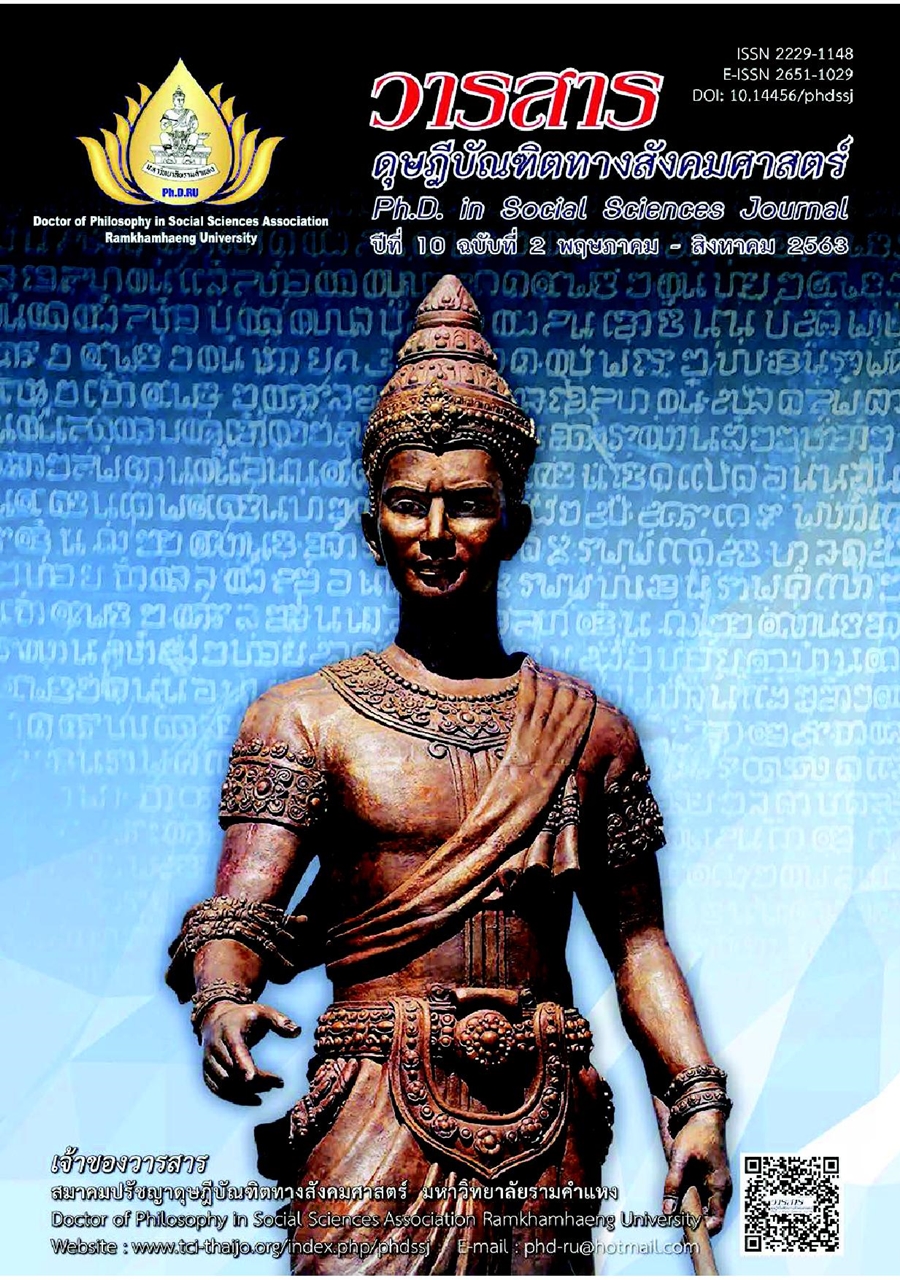ความสัมพันธ์เชิงสาเหตุของปัจจัยที่มีอิทธิพลต่อความสําเร็จทางธุรกิจของอุตสาหกรรมชิ้นส่วนไฟฟ้าและอิเล็กทรอนิกส์ในประเทศไทย
Main Article Content
บทคัดย่อ
บทความวิจัยนี้มีวัตถุประสงค์มุ่งเน้นวิเคราะห์รูปแบบความสำเร็จทางธุรกิจของอุตสาหกรรมชิ้นส่วนไฟฟ้าและอิเล็กทรอนิกส์ในประเทศไทยโดยเก็บข้อมูลจากกลุ่มตัวอย่างผู้ประกอบกิจการผลิตชิ้นส่วนไฟฟ้าและอิเล็กทรอนิกส์ในประเทศไทยจำนวน 385 ราย และทำการวิเคราะห์ข้อมูลด้วยโมเดลสมการโครงสร้าง (Structure Equation Model--SEM)
ผลการวิจัย พบว่า ตรวจสอบความสอดคล้องของโมเดลสมการโครงสร้างปรากฏว่าดัชนีทุกตัวผ่านเกณฑ์มาตรฐานผลการวิเคราะห์ที่ได้ครั้งนี้สอดคล้องกับข้อมูลเชิงประประจักษ์ ดังนั้น ธุรกิจสามารถนำโมเดลที่ได้ใช้เป็นเครื่องมือในการยกระดับผลการดำเนินงานของธุรกิจ เพื่อให้ธุรกิจมีผลการดำเนินงานที่ดีซึ่งเป็นพื้นฐานของความยั่งยืนในการสร้างความได้เปรียบทางการแข่งขันอันนำไปสู่ความสำเร็จทางธุรกิจ นอกจากนี้ ยังพบว่า ผลการวิเคราะห์ปัจจัยกลยุทธ์ทางการตลาดปัจจัยความสามารถเชิงพลวัตปัจจัยการจัดการนวัตกรรมทางเทคโนโลยีปัจจัยความสามารถทางการแข่งขันมีอิทธิพลทางตรงต่อความสำเร็จทางธุรกิจของอุตสาหกรรมชิ้นส่วนไฟฟ้าและอิเล็กทรอนิกส์ในประเทศไทย อย่างมีนัยสำคัญทางสถิติ
Article Details
บทความวิชาการ บทความวิจัย และบทวิจารณ์หนังสือในวารสารดุษฎีบัณฑิตทางสังคมศาสตร์ เป็นความคิดเห็นของผู้เขียน มิใช่ของคณะผู้จัดทำ และมิใช่ความรับผิดชอบของสมาคมปรัชญาดุษฎีบัณฑิตทางสังคมศาสตร์ มหาวิทยาลัยรามคำแหง (กรณีการทำวิจัยในมนุษย์ ผู้วิจัยต้องผ่านการอบรมจริยธรรมการวิจัยในมนุษย์ และนำหลักฐานมาแสดง)
เอกสารอ้างอิง
Bamossy, G. J., & Solomon, M. R. (2016). Consumer behaviour: A European perspective. Pearson Education.
Bogoslaw, D. (2010). Tough Times Spur Shifts in Corporate R & D Spending. Bloomberg Business Week.
Chairat S., Sewetomboon K., & Songsiroj, N. (2012). Relationship between systems Strategic Information and the Competitive Advantage of the Telecommunications Business in Thailand. Journal of Accounting and Management, 4(1), 69-78. [In Thai]
Chanchai, A. (2003). Towards business excellence. Strategic Planning and Preparation of BSC = Balanced Scorecard (6th edition) (revised version). Chulalongkorn University Printing House. [In Thai]
Chien, S. Y., & Tsai, C. H. (2012). Dynamic capability, knowledge, learning and firm performance. Journal of Organizational Change Management, 25(3), 434-444.
Cui, A. S., Griffith, D. A., & Cavusgil, S. T. (2005). The Influence of Competitive Intensive and Market Dynamism on Knowledge Management Capabilities of MNC Subsidiaries. Journal of International Marketing, 13(3), 32-53.
Damanpour, F. (1987). The adoption of technological, administrative, and ancillary innovations: Impact of organizational factors. Journal of Management, 13(4), 675-688.
Department of Industrial Promotion. (2017). Electrical and Electronics Industry, Retrieved from http://strategy.dip.go.th
Dholakia, U. M. (1997). An investigation of some determinants of brand commitment: ACR North American Advances. Association for Consumer Research.
Diamantopoulos, A., Siguaw, J. A., & Siguaw, J. A. (2000). Introducing LISREL: A guide for the uninitiated. Sage.
Drnevich, P. L., & Kriauciunas, A. P. (2011). Clarifying the conditions and limits of the contributions of ordinary and dynamic capabilities to relative firm performance. Strategic Management Journal, 32(3), 254-279.
Duangsang, K. (2015). The Causal Factors in Successful Management of Facade-based Business Operators in Bangkok and Its Vicinity. Doctor of Philosophy Management branch. North Bangkok University, Graduate school. [In Thai]
Electrical and Electronics Institute. (2017). Electrical and Electronics Industry. Retrieved from http://www.thaieei.com/2013/th/index.php
Hair, J. F., Anderson, R. E., Babin, B. J., & Black, W. C. (2010). Multivariate data analysis: A global perspective (7th ed.). Pearson.
Helfat, C. E., & Peteraf, M. A. (2003). The dynamic resource-based view. Strategic Management Journal, 24(10), 997-1010.
Jackson, S. E., & Joshi, A. (2003). Diversity in social context: A multi-attribute, multi-level analysis of team diversityand performance in a sales organization. Unpublished manuscript, Rutgers University, New Brunswick, NJ.
Jantunen, A., Ellonen, H. K., & Johansson, A. (2012). Do dynamic capabilities of innovative firms actually differ. European Management Journal, 30(2), 141-155.
Johannessen, J., & Olsen, B. (2003). Knowledge management and sustainable competitive advantages: The impact of dynamic contextual training. International Journal of Information Management, 23(4), 277-289.
Kaplan, R. S., & Norton, D. P. (1992). The Balanced Scorecard: Measures that drive performance. Harvard Business Review, 70(1), 77-79.
Kotler, P. (1997). Marketing management: Analysis, planning implementation and control (9th ed). Asimmon & Schuster.
Michailova, S., & Zhan, W. (2015). Dynamic capabilities and innovation in MNC subsidiaries. Journal of World Business, 50(3), 576-583.
Mohaghar, A., Fathi, M. R., Zarchi, M., & Omidian, A. (2012). A combined VIKOR–fuzzy AHP approach to marketing strategy selection. Business Management and Strategy, 3(1), 13-27.
Neely, A. D., Adams, C., & Kennerley, M. (2002). The performance prism: The scorecard for measuring and managing business success. London: Prentice Hall Financial Times.
Lok, P., & Crawford, J. (2000). The application of a diagnostic model and surveys in organizational development. Journal of Managerial Psychology, 15(2), 108-125.
Permavanichkun, P. (2014). Model on success for implementation of sole proprietorship e-commerce entrepreneurs in Thailand. doctor of business administration management. Khon Kaen University, Graduate School. [In Thai]
Rotsamrongkulpakdee, K., & Manahiranwet, P. (2015). Factors affecting decision to buy electronic components in type of capacitors of electrical and electronics appliance industrial factories. Journal of Humanities, Social Sciences and Arts, 8(3), 919-941. [In Thai]
Schilke, O. (2014). Second-order dynamic capabilities: How do they matter?. Academy of Management Perspectives, 28(4), 368-380.
Schumacker, E. R., & Lomax, G. R. (1996). A beginner’s guide to structural equation modeling. Erlbaum.
Thipsri N. (2015). Logistics management strategies and competitive advantages in the modern economy of OTOP businesses in Chiang Rai Province. Sri Pathum Journal Humanities and Social Sciences, 15(2), 17-25 [In Thai]
Tuan, N. P., & Yoshi, T. (2010). Organisational capabilities, competitive advantage and performance in supporting Industries in Vietnam. Asian Academy of Management Journal, 15(1), 1-21.
Utterback, J. M., & Suarez, F. F. (1993). Innovation, competition, and industry structure. Research Policy, 22(1), 1-21.
Vanichbancha, K. (2006). Statistics for research. Chulalongkorn University Press. [In Thai]
Yantawanitchai, T. (2010). IMC Integrated Marketing Communications. Academic Journal University of the Thai Chamber of Commerce, 30(2), 99-115. [In Thai]


